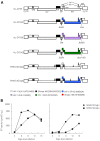Growth potentials of CCR5-tropic/CXCR4-tropic HIV-1mt clones in macaque cells
- PMID: 23908651
- PMCID: PMC3725405
- DOI: 10.3389/fmicb.2013.00218
Growth potentials of CCR5-tropic/CXCR4-tropic HIV-1mt clones in macaque cells
Figures

References
LinkOut - more resources
Full Text Sources
Other Literature Sources

